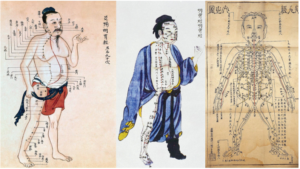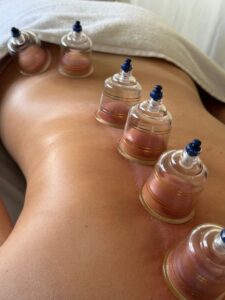✨ 6 Powerful Reasons Why Traditional Chinese Medicine (TCM) Is Having a Real Moment Right Now
It’s not just a trend—it’s a shift in consciousness. Across the globe, more and more people are turning to Traditional Chinese Medicine (TCM) as they search for real healing, not just symptom management. Here’s why TCM is resonating so deeply in our modern world:

1. The age of awareness: People are questioning the system and its symptom-based fixes.
We’re living in an age where knowledge is literally at our fingertips. With the rise of technology and easier access to information, more people are starting to ask tough – but necessary questions about the healthcare system.
Is it truly designed to heal us, or is it structured to keep us dependent?
Conventional medicine has achieved incredible things, especially in emergency care and life-saving interventions. But when it comes to chronic illness, mental health, or long-term imbalances, the approach is often symptom-based: take a pill, suppress the symptom, carry on. It’s fast, it’s convenient—but it doesn’t go deep. And the deeper people look, the more they realize this model often serves pharmaceutical profits more than it serves actual healing. They’re no longer satisfied with being passive patients – we want to be active participants in our own healing.
So…that’s where Traditional Chinese Medicine comes in.
TCM offers a completely different approach. It doesn’t reduce a person to a symptom or a diagnosis. It looks at the whole being – your body, your emotional state, your lifestyle, your energy, even the seasons you’re living through. The goal isn’t to “manage” a problem indefinitely. The goal is to restore harmony and create conditions in which healing can naturally occur.
In a world where people are tired of being told to “just live with it” TCM is a reminder that healing is possible – and that it starts with truly being seen.
2. Stress and burnout are everywhere – and conventional medicine doesn’t offer true healing.
Let’s be honest: burnout is the new normal.We’re constantly wired and rushing, just rushing through life, emotionally drained, mentally exhausted, and physically depleted.
Stress-related symptoms like anxiety, insomnia, hormonal imbalances, digestive issues, and chronic pain are becoming so common that they’re almost expected. But they’re not normal. They’re signals from the body, asking us to pay attention.
And yet, in the conventional medical system, these signals are often silenced instead of explored, And even more troubling, conventional medicine isn’t equipped to treat conditions that stem from emotional or mental imbalance rather than a clear physical cause.
When we seek help, we’re often handed quick fixes and while these tools can offer short-term relief, they rarely address the root cause. They don’t teach us how to restore balance, regulate our emotions, or reconnect with our body.
And again, Chinese Medicine shines.
Through modalities like of Qi regulation techniques, TCM treats stress and emotional stagnation at their source. These practices calm the nervous system, move stuck energy, and support the organs responsible for emotional processing – like the Liver (anger, frustration), the Heart (joy, anxiety), and the Spleen (worry, overthinking).
Instead of numbing the symptoms, TCM teaches the body how to feel safe again – how to return to a regulated state where healing is possible.
And it’s not just about the body – it’s about the whole person. The emotional and physical are never separate in Chinese Medicine. Your stress is not “just in your head” it’s in your muscles, your digestion, your sleep, your skin. And when we treat the whole system with care and intention, transformation really happens.
3. The Shift to Slow, Natural Medicine Is Real.
In a world obsessed with instant gratification, we’re starting to feel the consequences of moving too fast. We eat fast. We work fast. We expect fast results. But healing? Healing doesn’t work like that.
People are tired of band-aid solutions. Tired of suppressing symptoms. Tired of feeling disconnected from their bodies. There’s a rising desire to slow down, to reconnect with the rhythms of nature, and to heal in a way that feels sustainable and meaningful. So they’re turning to something else – something that feels ancient, intuitive, and deeply human. They’re turning to breath. To food as medicine. To herbal support. To movement. To rest. To touch.
Chinese Medicine doesn’t and will never promise a miracle cure overnight. But it offers something more valuable: a return to balance. A slower path that actually leads somewhere. And when people experience it – when they feel their nervous system calm, their digestion regulate, their sleep return, their emotions soften they realize: this is what healing feels like.
4. Social Media Is Giving Healers a Voice.
Thanks to technology advancements and social media, practitioners around the world are stepping forward and sharing their work in real time. You can watch videos of acupuncture needles gently placed along meridians, Tuina massage techniques easing chronic pain, cupping marks that spark curiosity, and herbal medicine rituals that feel both old and new.
Healers are using their platforms to tell real stories of transformation, resilience, and hope. They’re breaking down ancient concepts like Qi, Yin-Yang, or the Five Elements into language that resonates today. Showing that this medicine isn’t mystical or magical – it’s practical, effective, and deeply rooted in observation and nature.
People are listening and more importantly, they’re experiencing it for themselves. The mystery is dissolving. The stigma is fading. And in its place, a global community is forming – one that values holistic care, ancient wisdom, and personalized healing.
Social media isn’t just a tool for visibility anymore – it’s a bridge.
5. We’re Reconnecting With Ancient Wisdom.
There’s something happening on a deeper level. Beyond the trends, beyond the science, beyond the symptoms – people are starting to remember. We’re remembering that healing isn’t new. That long before hospitals and prescriptions, human beings looked to nature, the elements, the seasons, the breath, and the body itself for guidance. That wisdom still lives in us. And right now, more than ever.
Traditional Chinese Medicine is built on thousands of years of observation – not of diseases, but of people. It teaches us that our emotions affect our organs, that food can be medicine, that we’re connected to the cycles of nature, and that balance – not perfection – is the key to health.
This way of thinking is not just therapeutic. It asks us to slow down. To notice. To listen. It reminds us that we’re not separate from the world around us – we are nature, and our health is a reflection of how in or out of sync we are with it.
Reconnection to rhythm. To intuition. To meaning. To self.
And that’s why TCM isn’t just having a moment – it’s becoming a movement.
6. It Actually Works.
At the end of the day, the reason Traditional Chinese Medicine is gaining real traction is simple: it works. People come in with chronic back pain, migraines, digestive issues, anxiety, hormonal imbalances – things they’ve struggled with for months or years. They’ve tried everything. They’re tired, frustrated, and skeptical. And then they experience something different: a treatment that doesn’t just chase symptoms, but looks at the whole picture.
They leave a Tuina session feeling lighter in their body and clearer in their mind. They sleep better after acupuncture. Their cycle regulates after taking herbs. They feel grounded after moxa. Their body finally exhales.
And that’s just the beginning.
As more and more people experience these shifts for themselves, they start telling others. It spreads organically – because real healing is hard to keep quiet.
What’s even more exciting is that modern science is starting to catch up. Research studies are now confirming what TCM practitioners have known for thousands of years. This medicine isn’t just “ancient wisdom”—it’s functional, effective, and evidence-backed. And when people feel the results in their own bodies, it doesn’t matter if they know all the theory behind it. What matters is: they feel better. In a world full of overpromises and temporary fixes, that kind of real, embodied change speaks louder than anything else.
Traditional Chinese Medicine isn’t just a passing trend – it’s a return to what works.
A return to balance, to listening to our bodies, and to healing that honors the whole person. In a world of quick fixes, TCM offers something deeper: a path to true, lasting health.
It’s not about curing in the traditional sense it’s about restoring harmony and empowering individuals to heal themselves, mind, body, and spirit.
____________________________________________________________________________________________________________________________________________________________________________________________________
What Is Tuina? The Ancient Chinese Healing Technique You Need to Know

In the world of holistic healing, Tuina (Tui Na) stands as one of the oldest and most sophisticated forms of therapeutic bodywork. Rooted in Traditional Chinese Medicine (TCM), this dynamic practice blends manual therapy, acupressure, and energy regulation to restore balance and promote healing.
But what exactly is Tuina, and why is it gaining recognition?
A Tradition Spanning Thousands of Years Tuina has a history dating back over 2,000 years, with origins tracing as far back as the Shang Dynasty (17th to 11th centuries BCE). Ancient Chinese physicians recognized that touch and movement could be used to stimulate the body’s natural healing abilities. Over centuries, Tuina evolved, incorporating principles from acupuncture, herbal medicine, Qi Kong/Tai Qi and martial arts to create a complete therapeutic system.
During the Ming (1368–1644) and Qing (1644–1912) dynasties, Tuina was formally recognized as a key component of Chinese medical practice, with specialized schools training practitioners in its precise techniques. Today, Tuina is practiced worldwide as both a standalone therapy and a complement to other healing modalities.
How Tuina Works: Behind the Technique
At its core, Tuina focuses on the harmonization of Qi (vital energy) within the body. According to TCM philosophy, Qi flows through pathways called meridians, each meridian is or connected to an organ or a special organ, which are part of the beliefs of TCM’s philosophy, blockages of Qi or Blood in these channels can lead to pain, tension, and illnesses. Tuina employs a variety of techniques—such as grasping, kneading, rolling, pressing, and stretching – to remove these blockages, allowing Qi and blood to circulate freely.
Unlike conventional massage therapies, which primarily target muscles and soft tissues, Tuina goes a step further by engaging with specific acupuncture points and meridians. This makes it highly effective for treating a range of issues, from chronic pain and stress relief to digestive problems and emotional imbalances.
What Makes Tuina Unique?
Tuina is more than just a massage – it’s a form of medical treatment designed to address both the physical and energetic aspects of health. Here’s what sets it apart:
✔️ Integrative Approach – Combines elements of physical therapy and energetic healing, making it a holistic experience.
✔️ Root-Cause Focus – Treats underlying imbalances, not just symptoms, for long-term healing.
✔️ Adaptability – Techniques are tailored to each individual, making it effective for a wide range of conditions.
✔️ Dynamic & Engaging – Unlike passive relaxation massages, Tuina actively works to restore balance and function in the body.
Why Try Tuina?
If you’re looking for a therapeutic approach that nurtures every facet of your health, Tuina is worth exploring. Whether you’re seeking relief from chronic tension, recovering from an injury, or simply looking to harmonize your body and mind, Tuina offers a powerful and adaptable healing experience.
As a Tuina practitioner, I’ve seen firsthand how this practice can transform well-being, reduce pain, and restore energy. It’s a therapy that bridges the gap between ancient wisdom and modern health, offering a profound sense of renewal to those who experience it.
Have you ever tried Tuina? Or are you curious to learn how it could benefit you? Let’s start the conversation in the comments!

